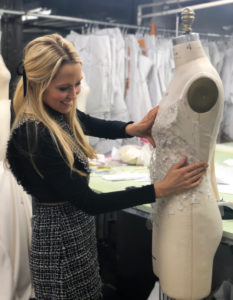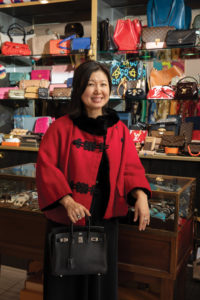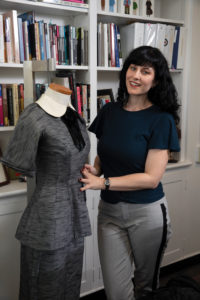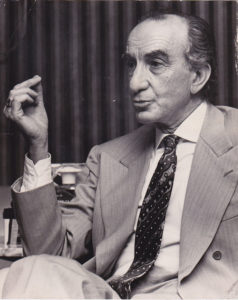You make a statement every time you leave the house.
The clothes you chose this morning—be they suit and tie or distressed jeans and a T-shirt—speak for you, telling those you encounter a story about who you are and what you value.
Whether you wear vintage Gucci or brand-new H&M, there are numerous players that make your everyday sartorial choices possible. From innovative textile makers and avant-garde designers to the fashion journalists tracking down and reporting on this season’s trends, the global fashion industry is valued upwards of $2.5 trillion dollars, according to the U.S. Congress Joint Economic Committee, and employs close to 2 million people in the U.S. alone.
UGA alumni are at the forefront of the industry’s niches, creating smart fabrics, building brands that resonate with modern trendsetters, and proving fashion is about so much more than just appearances.
Tosha Hays: The Innovator
Brands: Tommy Hilfiger; Bella Freud, London; Spanx; Tosha Hays Couture, Brrr°, AFFOA
Tosha Hays wants your clothes to do more for you.
Fabrics that keep you cool by dropping your body temperature several degrees. Running gear that lights up when headlights hit it. A backpack that connects to a social networking app. These are just a few of the products Hays BSFCS ’07 has had a hand in developing.
“For thousands of years, textiles haven’t changed,” she says. “Why can’t our fabrics make our lives easier?”
After a successful tenure helming Spanx’s creative design team, Hays was itching to do more. “I wanted to build a company that pushed textiles further than what people think they can do,” says Hays.
So, she and fellow former Spanx co-worker Mary-Cathryn Kolb founded brrr!, a company that specializes in technologically advanced textiles that cool the body temperature by 2 to 3 degrees. The company has produced not only its own line of apparel and accessories sold on QVC but also licenses its technology with apparel companies like Southern Tide, The Gap, and NinetyEight6, among others.
In 2015, Hays was introduced to the Advanced Functional Fabrics of America (AFFOA), a nonprofit headquartered at MIT with the mission of transforming fibers into networked devices and systems. (UGA joined AFFOA’s consortium in 2016.) The organization takes products from start to finish, drawing semiconductor technology through the fibers of textiles and partnering with everyone from the Department of Defense to industry giants like New Balance to create products that can change colors, monitor health, and more.
The mission of the organization aligned perfectly with Hays’ belief that fabric is much more than a commodity; it should provide a service for its wearer. “On your phone, you have the app store that offers you all these services,” she says. “What if you had a menu of fabrics that could do the same?”
Hays became AFFOA’s chief product officer in 2016, leading the team that brainstorms new, advanced fabrics and product ideas and then brings them to life.
“Every human is wearing textiles on their body every day of every year for the most part,” she says. “Imagine if instead of holding a cellphone up to my ear, I had fibers that were transmitting your voice to my ear through the fibers that were in the shoulder of my dress.”
With organizations like AFFOA and entrepreneurs like Hays, that day is coming soon.
Christy Plott: The Alligator Queen

Clients: Oscar de la Renta, Ralph Lauren, Prada, Lucchese Boot Company, Tom Ford
For a family that stumbled into the alligator leather business, the Plotts are dominating the high-fashion supply industry. And Christy Plott BBA ’02, in particular, is loving every minute.
The family-run, Griffin-based tannery, American Tanning & Leather, is the oldest and largest exotic leather tannery in the country and one of the final few that haven’t been bought out by haute couture fashion houses (though they do have an industry partner). Founded by Plott’s great-grandfather, the company has its roots in the 1920s fur trade. Fur season doesn’t last all year, so eventually Plott’s dad started looking for something that could complement the off-season. He had purchased some alligator skins in the ’80s and couldn’t find anyone in the U.S. to tan them.
“He had never set foot in a tannery in his life and said, ‘Well, we’ll just build a tannery!’ I think he thought it was going to be easier than it was,” Plott says with a laugh. “I don’t know how my parents stayed married.”
Now, the tannery processes about 25,000 skins (alligator and crocodile) every year, selling to luxury fashion houses like Oscar de la Renta, Prada, and Ralph Lauren among others. The family eventually left the fur business altogether.
Plott was key to securing the deals with high-end companies. Serving as marketing and creative director, VP of sales, and a partner, she studies fashion magazines like it’s her job, and, really, it is.
“I’ve had a couple of Carrie Bradshaw moments that were pretty cool,” says Plott. One was having Oscar de la Renta himself ask her back to his headquarters after she showed his team the range of colored skins she could have made for the company. Another was working with the then-up-and-coming designers behind Proenza Schouler to produce alligator skin leather jackets that sold for $60,000 a pop.
Plott’s grown to know what each fashion house is looking for, becoming somewhat of a mind reader when it comes to which designer will want which colors of leather.
“What a job for a country girl from Griffin, Georgia, to work and be out in the bayou, ride on airboats, and work with alligator farmers and hang out with them, and then get to go to Paris or a runway show and get dressed up,” Plott says. “It worked out well that I was the girl in the family because the boys didn’t want any part of this.”
Allison Webb: The Embellishment Expert

Brands: Oscar de la Renta, J. Crew, Tory Burch, Ann Inc., JLM Couture
In high school, Allison Webb bought a dress for prom just like all the other girls. But then she asked a seamstress to cut it apart and reshape it, just how she wanted it.
In hindsight, that might’ve been a sign that she was destined to work in fashion.
Webb AB ’05 headed to New York’s Parsons School of Design in 2007 when she realized fashion design was what she was meant to do.
Her first internship was with Chado Ralph Rucci, doing a little bit of everything from helping to hand-finish garments to assisting backstage at Rucci’s show during Mercedes-Benz Fashion Week. That job was followed by a career-defining stint at Oscar de la Renta, where Webb perfected her embellishment techniques while working with the designer himself and his team on the collections.
When Webb’s former manager from Oscar began working for Ann Taylor, she snatched Webb up to design wedding dresses for the company, introducing her to the bridal business almost by accident.
Webb fell in love with bridal, and after reaching out to JLM Couture, a New York-based bridal house, she ended up with not one but two lines bearing her name, Allison Webb and Ti Adora by Allison Webb.
“You’re limited in your color palette, so it forces you to become more creative in what you’re doing,” she says. “Because you’re not focused on color or print, you can really focus on the details.”
 In the Ti Adora line, those details manifest in embroidered lace, perfectly placed ruching and seams, and buttons running the entire length of a gown. The dresses are perfect for the romantic bride, the ones getting married on the beach or in rustic barn settings. Her namesake line is a bit sleeker, more modern with dramatic ballgowns and oversized bows adding black tie touches.
In the Ti Adora line, those details manifest in embroidered lace, perfectly placed ruching and seams, and buttons running the entire length of a gown. The dresses are perfect for the romantic bride, the ones getting married on the beach or in rustic barn settings. Her namesake line is a bit sleeker, more modern with dramatic ballgowns and oversized bows adding black tie touches.
“Meeting with brides when I go around and do shows is a really gratifying experience,” Webb says. “Seeing them choose your gowns and cry, and their moms are crying. Half the time I’m crying with them, and I don’t even know them. The dress will be in their pictures that they’ll look at for the rest of their life, so I feel like it’s an honor to be able to design their dresses.”
Sarah Conly: The Trend Setter

Publications: The New York Magazine, Harper’s Bazaar, InStyle, Cosmopolitan, Seventeen
Magazine editors used to be the only ones who shaped what was in and what was out, carefully selecting pieces to feature in spreads that would be pored over by fashionistas around the world.
Then Instagram happened.
Sarah Conly ABJ ’00 was an associate at Harper’s Bazaar when the curated, visual medium blew up. The shakeup to the magazine industry was immediate.
“Before Instagram, editors were kind of a conduit taking the designer’s vision and translating it or putting a creative spin on it,” Conly says. “It’s way more democratic now because Instagram gives up-and-coming brands and designers exposure that they wouldn’t have had otherwise. But you don’t have the luxury of time.”
The popular social app also opened doors for social media darlings to develop online personas that morphed into full-time careers as influencers. Models are discovered on Instagram. And small brands are able to break out of the pack through their online presence.
Magazines had to adapt quickly to the new platforms, creating content that played to digital strengths. High-impact visuals, looped videos, memes, and GIFs. More content faster. During her time at Cosmopolitan, Conly saw one of the most popular women’s magazine brands cultivate a social persona that engaged its loyal readership but also brought new followers into the fold. Facebook, Twitter, Instagram, and Snapchat gave magazines—and editors—the ability to react to current events and interact with readers in a way print couldn’t.
 “I feel lucky that I’ve been able to see both sides of the industry,” Conly says. “I think people’s relationship to media has changed, but I hope people will still take that time to spend time relaxing with a brand and kind of getting lost in magazines like we used to. I still love going to a nail or hair salon and sitting down with a magazine.”
“I feel lucky that I’ve been able to see both sides of the industry,” Conly says. “I think people’s relationship to media has changed, but I hope people will still take that time to spend time relaxing with a brand and kind of getting lost in magazines like we used to. I still love going to a nail or hair salon and sitting down with a magazine.”
As fashion market director at Hearst Women’s Fashion Group, Conly produced content for a variety of Hearst publications, both in print and online, and also managed relationships with brands to secure clothing and accessories for photoshoots, working with fashion directors to bring their concepts for spreads to life.
“It’s an interesting time in our industry,” says Conly, who recently relocated to Los Angeles to pursue freelance styling jobs for magazine editorials, brands, and red carpet events, in addition to continuing to write and consult. “People are doing more with less and still finding ways to be creative and push the creative boundaries.”
Airee Edwards: The Vintage Virtuoso

The Goods: Chanel, Louis Vuitton, Hermés
Airee Edwards wasn’t sure what she wanted to do when she graduated from UGA with a bachelor’s in fabric design, but she knew she wanted to stay in Athens.
So she looked for a business opening, asking herself what was missing, what did Athens not have?
The answer: an open market where anyone could sell their vintage furniture, handcrafted items, art, or whatever, really.
“I went to what seemed like every bank in Athens, and I heard a lot of no’s,” Edwards AB ’99 says. But with savings from waiting tables and taking money off the house she’d bought, “a risky move” as she describes it, Edwards convinced a local bank to lend her what she needed to open Agora in 2002. (Agora means “open marketplace” in Greek.)
The only problem? Edwards didn’t have a business degree. But growing up, she’d followed her mother from one craft fair to the next, selling tissue box holders they fashioned from vintage fabrics. That early exposure to entrepreneurship stuck with her.
So she learned as she went, eventually outgrowing the little shop at the corner of Clayton and Pulaski. Sellers had also begun bringing in higher-end items, including women’s clothing and accessories, and Edwards’ husband, attorney and Athens-Clarke County Commissioner Russell Edwards JD ’10, suggested she move the fashion items to a new store a few blocks away on Broad Street, right across from North Campus.
For a while, the Edwards family headed both stores, an exhausting but incredibly rewarding job. But she eventually decided to focus on one of her first loves—fashion—and grow the now iconic vintage fashion store on Broad, selling the furniture store that would become Atomic Vintage.
When you walk into the recently renovated Agora Vintage, you see an Art Deco-inspired cabinet lined with bags from Chanel, Louis Vuitton, and Hermès, just to name a few. But there are also less expensive, gently used Coach, Tory Burch, and Marc by Marc Jacobs bags toward the back of the store. The counter display is full of beautiful, estate jewelry.
To the left, rows of vintage and modern clothes, all marked significantly below retail. Designer shoes are toward the back.
But what makes Agora Vintage stand out is Edwards herself. She’s almost always in the store, greeting customers, suggesting items she knows they have to have, and tracking down pieces they’ve inquired about. It’s that attention to detail that has landed Agora several times on the Bulldog 100, which lists the fastest growing buinesses owned or operated by UGA alumni.
But she never forgets the place that made it all possible, regularly speaking in classes at UGA and supporting the Georgia Museum of Art.
“I tell them the whole story about how I couldn’t get a loan and was eating potato chips for a year, thought I was going to get scurvy,” Edwards says. “I now own a business that allows me to live securely and enjoy some success. UGA helped me build that.”
Monica Sklar: The Punk Professor

Expertise: Modern social movements and subcultures, 20th/21st century design
To Monica Sklar, fashion is about much more than just what’s in and what’s out.
Fashion is where history and culture intersect.
“Fashion is usually thought of as something hyperfunctional or hyperfrivolous, and it’s neither of those things,” says Sklar, an assistant professor of textiles, merchandising, and interiors in the College of Family and Consumer Sciences and liaison to the Historic Clothing and Textiles Collection at the university’s Special Collections Libraries. “It’s a record of where we are in society and in the arts as much as literature, film, and photography are. And it’s extremely accessible to people to understand because everybody engages with it in some way or another.”
Sklar specializes in subcultures and social movements, with punk being an area of expertise. In addition to being a personal interest, punk is an understudied area of scholarship in fashion. When boiled down, punk is about questioning the boundaries and rules of mainstream society, but Sklar says it’s about so much more than that.
“It’s a lifestyle movement with an ethos,” she explains. “It’s an umbrella term with a tremendous amount of aesthetic cues built under it that generally then would communicate pushing the boundaries of beauty standards, pushing the boundaries of production and consumption methodologies. It’s too simplified when people call it anti-fashion, and it’s too simplified when people say it’s just a rebellion.”
Emilio Pucci: The Print Master

His name connotes high-fashion royalty now, but in the 1930s, Emilio Pucci M ’36 was simply a noble-born son of a family that was heavily entrenched in Tuscany’s agricultural world. Somehow, the Italian aristocrat made it all the way across the Atlantic to the University of Georgia to learn the latest agricultural techniques to benefit the family business.
He created a one-man ski team at the university and was active in UGA’s chapter of the Demosthenian Literary Society.
But farming wasn’t where his heart was.
He left UGA and ended up at Reed College in Portland, Oregon, where he earned a master’s and designed his first item of clothing: the Reed College ski team uniform.
When he returned to Italy in 1937, he served in the Italian air force through the war and after. He received his first commission as a designer a decade later. A commission to design a line of ski clothes followed, and Pucci became one of the first Italian designers to sell in the U.S. after the war. His domestic popularity skyrocketed when he reached deals with Saks Fifth Avenue and Neiman Marcus.
As he built his fashion empire, Pucci’s name became synonymous with bright, colorful designs and patterns on otherwise simple cuts, characteristics that continue to be prevalent in Pucci products to this day.
Pucci also maintained a presence on UGA’s Cortona campus, guest lecturing and narrating the Summer of Joy, a 1978 documentary celebrating the 10th anniversary of UGA’s partnership with the Italian town.
Prior to his death in 1992, Pucci returned to Georgia to participate in a high-end fashion show to benefit a boarding school in the state and for his induction into the Demosthenian Wall of Fame.



